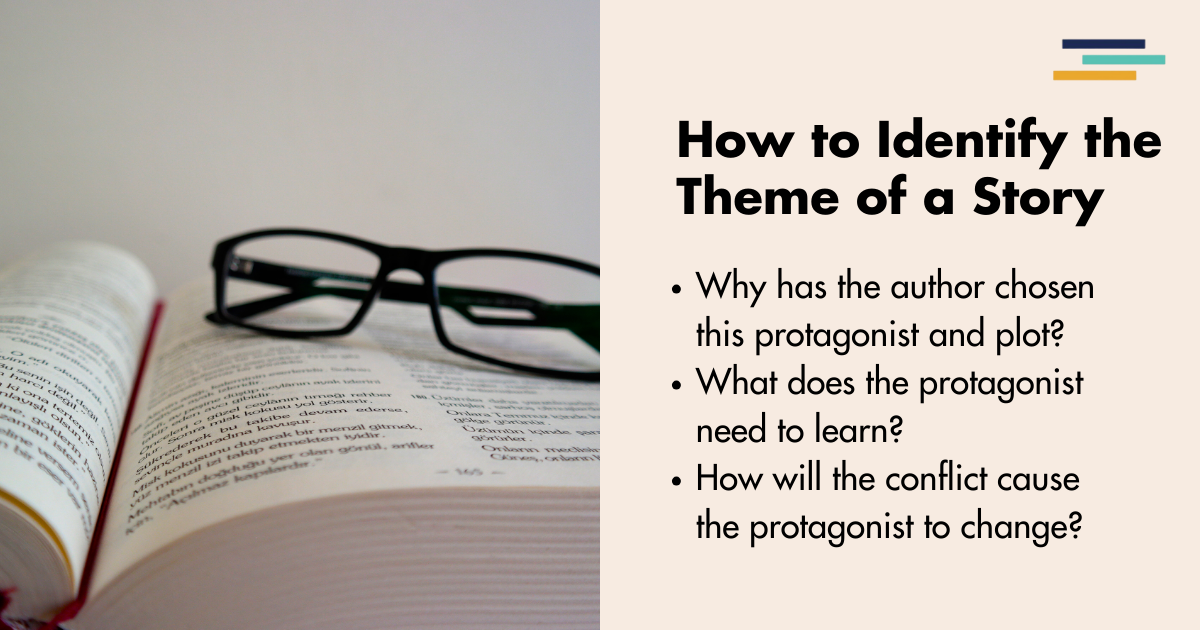
Have you ever wondered whether your story has a theme, or wanted to know how to integrate a theme or themes into your story? In this article we’ll look and what a theme is, and how you can use your story’s structure to develop your themes.
What is the Theme of a Story?
Memorable stories usually contain key themes, even though these themes may not always be obvious.
Great stories contain underlying messages, or ideas, which power the story’s narrative and character arcs.
Some stories, especially in the genre of literary fiction, contain multiple complex, often ambiguous, messages, which leave a great deal of room for reader interpretation. Other stories, especially those considered as commercial fiction, may contain fewer, more straightforward messages.
These messages provide stories with depth and relevance to the reader’s own life. These messages help readers learn about the world through fiction.Relevant, well-depicted themes are often why we remember some powerful stories for months or years to come.

How to Identify the Theme of a Story
Great literary works often contain multiple overlapping, interlacing themes, and the task of identifying and analyzing these themes can be complex. That’s why countless books of literary criticism have been written on Shakespeare’s plays.
However, although you could write a PhD on this subject, it’s also possible to provide some basic, simple steps for identifying a story’s key theme or themes.
A story’s key theme can usually be found in the intersection between character and plot.
Ask yourself:
- Why has the author chosen this protagonist and plot?
- What does the protagonist need to learn over the course of events?
- How will the story’s conflict cause the protagonist either to grow and succeed in their goals or to stagnate and fail?
If you’re familiar with the classic three-act structure, you’ll already know where you can most easily identify the protagonist’s learning journey within a story. It’s where the protagonist experiences their darkest, lowest moment and learns the lesson they need to.
This happens at Plot Point Two, which occurs at a story’s 70–80% mark.
Look at some of your favorite stories. Go to the 70–80%t mark of the story, and read to see what the protagonist discovers (or fails to discover) here. Chances are, this will give you an insight into the story’s key theme, or message. You’ll gain a greater insight into what the story is actually about.

Examples of Theme in a Story
Be warned that there are some spoilers in the following section, so feel free to skip this if you have not yet read The Hunger Games or The Secret History.
The Hunger Games by Suzanne Collins
At the 70% mark (Plot Point Two) of this Young Adult dystopian thriller, Katniss learns that she needs to work with her fellow tribute Peeta, rather than against him, to increase her chances of surviving the Games.
This key message is delivered to Katniss via her mentor Haymitch, who rewards her with gifts each time she shows willingness to work with Peeta.
As we move into the 75–80% mark of the story, Katniss is further rewarded for working with others. Her life is saved by another tribute, Thresh, who chooses to save Katniss on account of her former willingness to help Rue, a girl from the same district as him.
From these scenes, we can see that some of the key themes of the story are:
- Survival: what Katniss must do to ensure she survives the Games
- Rebellion and Teamwork: ensuring the oppressed work together to fight the oppressor
- Trust: figuring out who is trustworthy and who isn’t, and then acting upon that trust
You may identify other themes, and that’s absolutely fine. In fact, that’s one of the joys of analyzing themes. Reader interpretation plays an important role.
One reader isn’t necessarily more right than another. What matters to each individual is the message they take and remember from the story.
The Secret History by Donna Tartt
This adult literary thriller contains multiple story themes. It isn’t possible to explore them all to the full extent they deserve in this article, but we can look briefly at what the protagonist Richard learns at Plot Point Two to identify some of the story’s most important themes.
At the 70–80% mark of the story (Plot Point Two), Richard attends the funeral of Bunny, the boy he and his friends killed. At this point in the story, Richard has yet to take full moral responsibility for his part in this heinous crime.
His determination to reach higher social echelons, to feel as though he belongs with the wealthy, superficial students in his Classics class, has prevented him from accepting how reprehensible their joint actions have been.
At Plot Point Two, Richard accepts that Camilla, the girl from his Classics class he’s infatuated with, is “such an expert actress it was impossible to know if (she) was genuine.”
Richard also realizes the extent of Bunny’s parents’ social climbing aspirations. The dead boy’s parents appear delighted that certain members of society have attended their son’s funeral, rather than being devastated over their son’s death.
Richard finally understands the pernicious, hollow nature of the wealthy people he’s been admiring. Realizing this, he begins to feel a spark of genuine remorse:
From these scenes, we could analyze some of the key themes in the story as:
- Wealth, Class and Social Climbing
- Guilt, Responsibility and Remorse.
- True Identity vsSuperficial Presentations
In a literary work like this, you’ll usually find multiple themes in the story, along with great scope for reader interpretation.
How to use Story Theme in your Writing
Tip 1: Ensure the theme of the story is embedded into your story’s structure.
Ensure you’ve shown aspects of your story’s theme within each key plot point scene within your story. That includes the Inciting Incident (within the first 15%), Plot Point One (20–30% mark), the Middle (45–55%), Plot Point Two (70–80%) and the Climax scen (85–95%).
It’s important to show your themes and not rely on simply stating them. Whether your protagonist succeeds or fails at their specific goals within these scenes, the outcome should be linked to your story’s key theme or message.
For example, in The Hunger Games, at the 23–27% mark (Plot Point One), Katniss and Peeta show off their skills in the training arena. Despite her unwillingness to work with Peeta, Katniss realizes that the two of them share common ground, and that if she’s to die, she hopes Peeta wins.
After realizing that her true enemy is the Capitol, not her fellow tributes, Katniss puts on a furious spectacle of her own abilities, thus greatly improving her popularity and increasing her chances of sponsorship.
By implicitly grasping the story key’s message, that she must work with her friends to survive, Katniss succeeds at her goal for this scene whilst improving her ultimate prospects of survival.
Here, Suzanne Collins subtly shows us her story’s theme through action, rather than simply stating it.
Your story’s key themes should be particularly prominent at the Plot Point Two scene. If your protagonist experiences their lowest point here, this should be directly related to their failure to grasp the story’s main message.
At the Climax, by showing the protagonist’s eventual success or failure as dependent upon their growth arc and change, you will further elucidate your story’s primary theme.
Tip 2: Avoid thematic confusion by focusing your key themes on your main plot, and keeping secondary themes to your subplot(s).
Most stories have multiple themes. You want to ensure your various themes work together to strengthen each other, rather than allowing a plethora of themes to cause confusion, undermining your story’s overall message.
The simplest way to keep track is to assign different themes to your plot and subplots. Then you need to check that themes complement each other.
For example, in The Hunger Games, you could say that the main plot (Katniss winning the Games) revolves around the theme of survival.
The love triangle between Katniss, Peeta, and Gale forms an important subplot, in which we question more closely the themes of love and friendship.
Collins interweaves the subplot and main plot together with immense skill, ensuring her subplot’s thematic question (does Katniss care for Peeta?) becomes a critical question within her story’s climax scene. Here, Katniss outfoxes her true enemy, the Capitol, by showing herself willing to die to save Peeta.
The subplot thus becomes an integral element of the main plot, and the various themes (Survival, Rebellion, Trust, Teamwork, Love and Friendship) all work together to strengthen the climax scene.
Tip 3: Decide how much scope for reader interpretation you want your story to have.
It’s important to consider your story’s genre when making this decision.
For example, a commercial romance (such as Helen Fielding’s Bridget Jones’s Diary) will generally be most likely to find favor with its target readers if the theme of the story is, very clearly, love conquers all. If your commercial romance’s main theme could just as easily be interpreted as love rarely wins the day, you may find your story garners some negative reviews from disappointed readers!
A literary romance, on the other hand, (such as Sebastian Faulks’s Snow Country) has far greater scope for melding themes and playing with the traditional expectations of romance. The reader may be quite satisfied ending the book by questioning whether love really has won or not.
Whilst it’s important to be aware of genre conventions, always beware taking this advice to the extreme.
Any commercial story which carries absolutely no scope for reader interpretation runs the risk of leaving the reader feeling uninvolved, bored, and as though they’ve received a dull lecture.
Any literary story which gives the reader absolutely no guidance on how to interpret its key themes, however, runs the risk of leaving the reader confused, or taking away a completely irrelevant (and, at worst, possibly even offensive) message from the story.
As the story’s author, it’s up to you to decide where on this spectrum you want your story to fall, in terms of how much guidance you provide the reader on thematic interpretation.

Good Themes for Stories
Countless story themes exist.
To get you started on ideas, here’s a list of some popular story themes, which you’ll find in abundance in literature.
- Good versus Evil
- Identity
- Truth versus Lies
- Survival
- Freedom
- Love
- Family
- Friendship
- Trust
- Justice
- Social versus individual responsibilities
- Power
- Revenge
- Redemption
- Faith
- Corruption
- Innocence and Experience
- Free will
- War
- Dictatorship versus Democracy
- Chaos versus Order
- Nature versus Nurture
The best way to choose your own story’s theme is to consider carefully:
- Why did you choose this specific protagonist, and this specific plot?
- What is it that makes you care so deeply about telling this story?
In the process, you may learn a lot about yourself as both a writer and as a person!
Theme of a Story Conclusion
For some writers, the themes of a story are at the forefront of their mind when they write. For others, themes will reveal themselves slowly and organically as the story unfolds, either through writing or editing.
But once you’ve chosen the key themes of your story, you may find you’ve shed a new light on what your story is actually about, both for yourself and for your readers.
Once you’re clear on your story’s deeper meaning, you’ll be well placed to ensure you’ve integrated theme into your story’s structure as you write or edit. In doing so, you’ll find yourself able to show your reader, rather than just tell them, what your story’s about.
And doing so will help you create the most powerful, memorable story you can tell.


